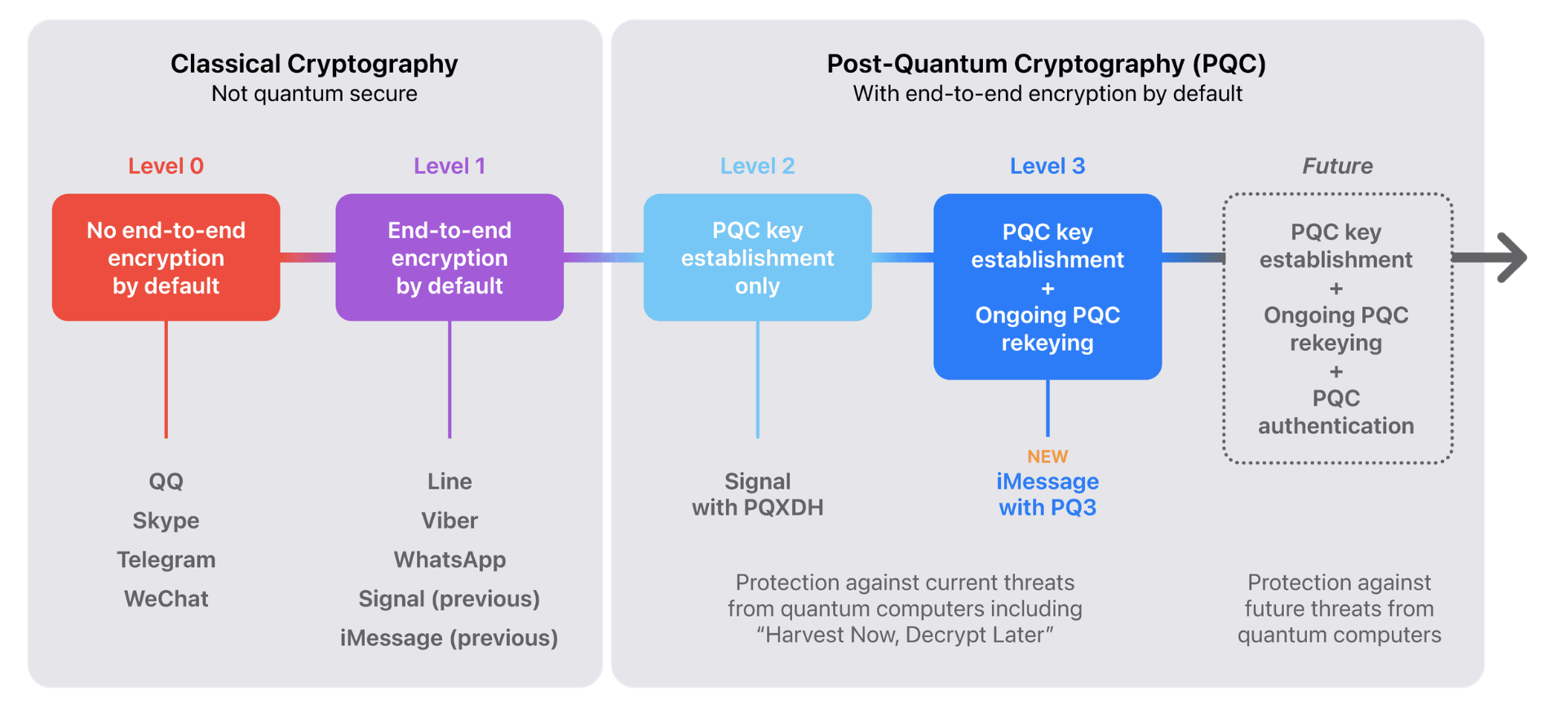Insider Brief
- Apple said its iMessage service is ready for post-quantum cryptographic era.
- In a company blog post, the Apple security team announced PQ3, a pioneering PQC protocol.
- iMessage with PQ3 secures not just the initial key exchange but all subsequent messaging, thereby achieving the coveted Level 3 status.
In a company blog post, Apple announced a significant step in establishing cryptographic security for its iMessage service to advance into the post-quantum cryptographic era by marking the debut of PQ3, a pioneering PQC protocol.
The company writes states that the protocol represents one of the most significant upgrades to iMessage’s security framework since its inception, setting a new benchmark for secure messaging on a global scale. According to the post, with PQ3, Apple introduces Level 3 security, a tier that surpasses the protections offered by any other widely deployed messaging application, ensuring resilience against sophisticated quantum computing threats and other advanced attacks.
Post-quantum cryptography (PQC) is becoming increasingly important and timely due to the rapid advancements in quantum computing. Quantum computers, while still in the developmental stages, promise to offer computational capabilities far beyond those of today’s classical computers. This leap in computational power, however, also poses significant risks to current cryptographic standards.

The Apple team suggests that even if quantum computers can’t hack cryptographic standards today, that doesn’t mean current data is safe.
They write: “Although quantum computers with this capability don’t exist yet, extremely well-resourced attackers can already prepare for their possible arrival by taking advantage of the steep decrease in modern data storage costs. The premise is simple: such attackers can collect large amounts of today’s encrypted data and file it all away for future reference. Even though they can’t decrypt any of this data today, they can retain it until they acquire a quantum computer that can decrypt it in the future, an attack scenario known as Harvest Now, Decrypt Later.”
The blog post explains that, in the realm of secure messaging, applications are typically gauged on a spectrum that ranges from classical cryptography to quantum security. Historically, most messaging services have either lacked end-to-end encryption or, at best, offered it without safeguards against quantum computing threats. Strides were made towards addressing this gap recently with the PQXDH protocol, achieving what’s referred to as Level 2 security by incorporating post-quantum security during the initial key exchange. However, iMessage with PQ3 transcends this by securing not just the initial key exchange but all subsequent messaging, thereby achieving the coveted Level 3 status.
Since its launch in 2011, iMessage has been at the forefront of secure messaging, being the first widely available app to offer end-to-end encryption by default, according to the writers. Apple has consistently enhanced its cryptographic protocols, most notably in 2019, by transitioning to Elliptic Curve Cryptography (ECC) and incorporating additional layers of security such as periodic rekeying and protection of encryption keys within the device’s Secure Enclave. These advancements have been rigorously verified through symbolic evaluation, ensuring a high level of security against potential attacks.
The advent of quantum computing presents a formidable challenge to the cryptographic underpinnings of secure messaging, threatening to undermine the security of classical algorithms such as RSA and ECC. Recognizing this emerging threat, Apple’s PQ3 protocol is designed to safeguard against both current and future quantum computing capabilities. By incorporating post-quantum cryptography from the outset of a conversation and throughout the messaging process, PQ3 ensures that all communications are shielded from potential quantum computing breakthroughs.
By integrating post-quantum cryptography into the very fabric of iMessage’s security protocols, the Apple team hopes to not only sets a new standard for secure messaging but also addresses the critical challenge of key compromise. A few key points on on that:
- The protocol employs a hybrid approach that combines new post-quantum algorithms with existing ECC algorithms, ensuring that the security of iMessage conversations is never less than that provided by classical protocols.
- This approach is further bolstered by a novel rekeying mechanism that enables cryptographic self-healing.
- Further, the approach ensures that the security of conversations can be rapidly restored in the event of a key compromise.
As the cryptographic landscape continues to evolve in response to the advancement of quantum computing, Apple’s introduction of PQ3 represents a significant milestone in the quest for quantum-resistant secure messaging. With the rollout of PQ3 across iOS, iPadOS, macOS, and watchOS, iMessage users will soon benefit from the highest level of security available, safeguarding their communications against the most advanced threats.
Zooming out, this development reinforces Apple’s position as a leader in secure messaging but also sets a new standard for the industry. The move is likely to ripple across elements of the industry that are preparing their own post-quantum cryptographic solutions, but also serve as a wake-up call to businesses and organizations that are currently not either ready for PQC, or ones that are not even aware of the potential for quantum computers to crack their data and network security systems.
For a more detailed dive into the PQC advance in the iMessage system, please see the blog post..
If you found this article to be informative, you can explore more current quantum news here, exclusives, interviews, and podcasts.

















